Back came a reply in Chinese, so I forwarded it to the Taipei Trade Centre in Wellington with a request for a translation. The response was swift. I had sent on an out-of-office auto reply.
Thankfully, reading Chinese was not required at the expo, as all the signage was in English, too, and if some of the plants lacked labels, that had more to do with the constant refreshing of displays than any lack of commitment by the Taiwanese.
Set up in Switzerland in 1948 to stimulate international marketing of flowers, plants and landscaping services, AIPH held its first expo in Rotterdam in 1960.
The initiative to host the show came from Taipei's Mayor Hau Lung-bin, who has staked his political career on its success and is confident of getting a financial return of at least twice the $420 million spent on the event.
The day before the expo officially opened, Mayor Hau told visiting journalists: "We have to amend our attitude, as we need to co-exist with nature [and our] long-term goals include raising environmental awareness for the entire country for future generations."
The EcoArk, the use of solar energy and water-conservation techniques at the expo are fascinating, but for the gardener, other aspects stand out - the immaculate presentation of vast beds of flowering plants; the carefree use of orchids, with up to 1000 species and cultivars on show; one of the world's best displays of bonsai; and the Pavilion of the Future, which showcases agricultural and gardening technologies.
To do all this over six months will take some 32 million plants, divided into five flowering periods, with 90% grown in Taiwan.
The 33 international gardens concentrate more on national features than innovative landscaping. The designs are very good, though, from Palau's delightful Pacific beach scene to Thailand's exuberant orchid displays and Oman's traditional fort surrounded by roses. At night, the Philippines' church tower stands out for its well-lit appearance.
Because the show is open until 10pm each day, visitors should plan to see open-air displays in daylight and go in the evening to the various halls, such as the Expo Dome with its floral exhibition and flower-arranging contests and demonstrations.
Although I visited the expo three times in five days, spending some 11 hours on site, I missed some exhibits requiring separate tickets and did not get to take the Blue Highway, a sightseeing trip on the Keelung River that runs through the expo.
Even those with no interest in bonsai will be awed by the works on display, so valuable that each is insured. At any one time, 100 are on display and 460 will make their appearance as the seasons change.
By the fourth day of the expo, the bonsai was proving one of the most popular segments, although the garden created by Shanghai was also a winner, in part because of the superb tree peonies on show.
If the standard can be maintained - and Mayor Hau wants every day to look "like the first" - Taipei's place on the floral expo circuit will be assured.
FACT FILE
The Taipei International Flora Exposition runs until April 25, 2011, and those interested in orchids could combine a visit to it with the 2011 Taiwan International Orchid Show in March. For more about the expo, visit www.2010taipeiexpo.tw
• In Taipei, Gillian Vine was the guest of the Taiwan Government Information Office.













